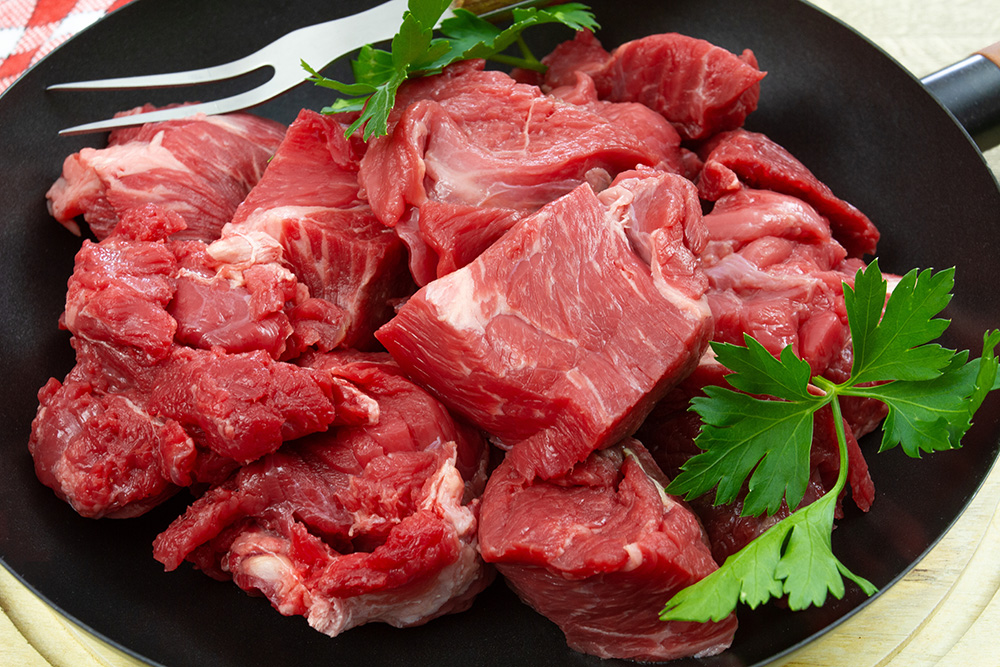Elevate Fresh Meat Displays with Promolux Lighting
Showcasing Fresh Meat at Its Finest
When considering Promolux lighting, we always recommend beginning with service and self-serve meat cases because the investment in product in these types of cases is very high. Furthermore, as it is perishable, any discoloration, dehydration, or degradation of the product is noticeable immediately.
Promolux lighting showcases fresh meat in the best possible light, attracting customers to your displays, while at the same time minimizing the damage caused by regular lighting and temperature changes.
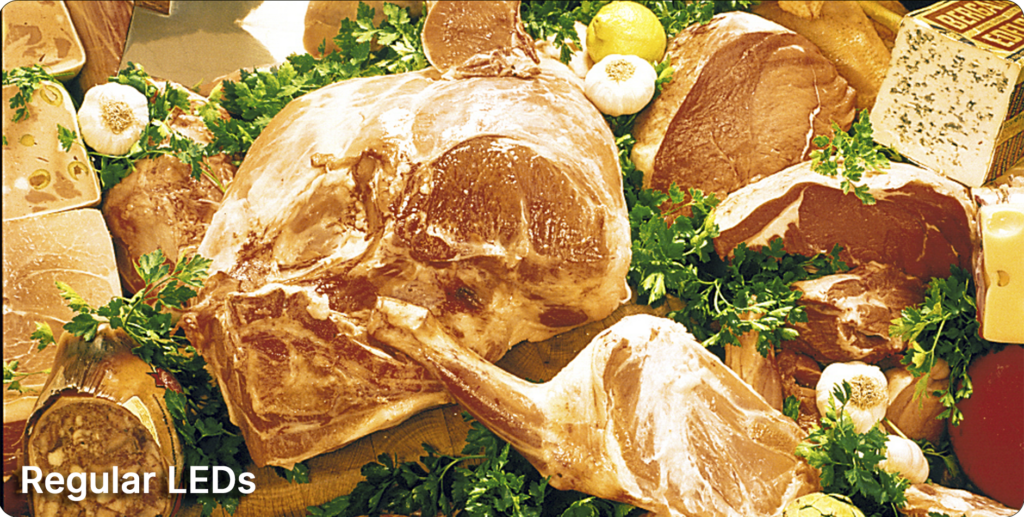
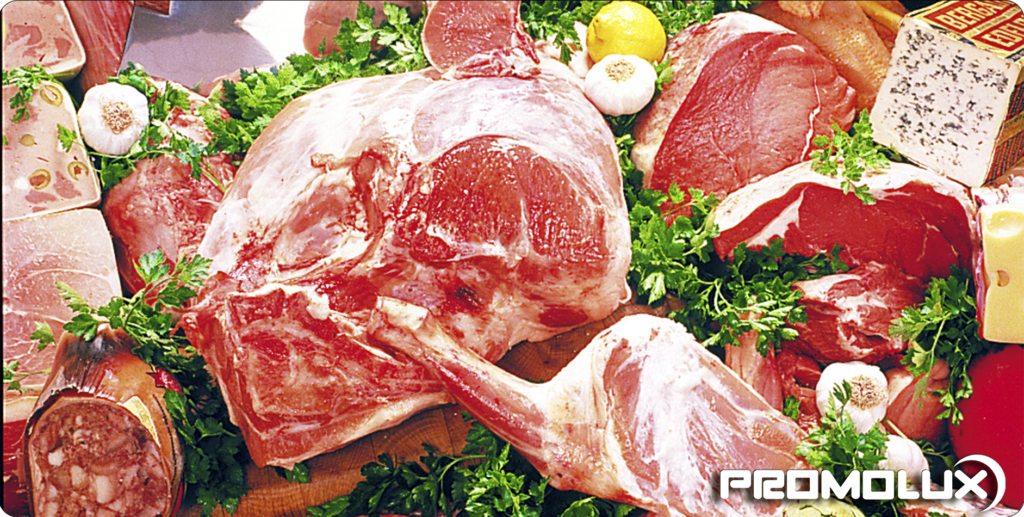
Enhancing Fresh Meat Appeal
Gourmet LED Lighting Solutions for Top-Notch Display Cases
Improper fresh food retail lighting impacts meat displays in several ways. First, regular LED lighting can alter the color, smell, flavor, of meat and increase the rapid rate of spoilage significantly affecting the sell-ability of that item.
The popularity of organic foods has even transcended into the meat showcases of butchers and gourmet meat shops and delicatessens. Organic meats are now prominently on display and with fewer preservatives, they are even more sensitive to the effects of case lighting.
Gourmet food retail shoppers are more likely than ever to select meat based on its color and freshness. In fact, many studies have shown that color is the primary means by which consumers judge meat juiciness, tenderness and flavor.
Elevate Display Quality with Promolux LED Lighting
Fresh Meat Display LEDs
Farm fresh butcher shops and local grocery stores can extend the shelf life of their meat products and add to the sales value and profitability of the case by using a food light like Promolux which is specifically engineered for fresh food retail displays. Promolux LEDs designed for meat lighting, protect the bloom, the natural juices and flavor of assorted meat products, and processed and cured meats, ensuring shoppers are more satisfied with their purchase.
When it comes to fresh meat merchandising and protection there is simply no other lamp that can compare to Promolux.
Bacterial Growth in Meat Displays
The Impact of Specialized Lighting on Meat Preservation
Regular supermarket meat display case lighting, with its heat, inadvertently creates the perfect breeding ground for bacteria on fresh meat. This elevated temperature encourages bacterial growth, making it a pressing concern. Even vacuum packaging, often seen as a safeguard, can’t fully prevent bacterial spoilage, costing Canada a staggering $200 million annually due to lactic acid bacteria affecting vacuum-packed beef.
The key culprits in meat spoilage are psychrotrophic bacteria, specialized in thriving in cold temperatures, primarily from the Pseudomonas genus. Other species like Moraxella, Psychrobacter, and Acinetobacter are also contributors.
In ground meats, bacteria are distributed throughout the product during the grinding process, while in other cuts, they are concentrated on the surface. Though generally harmless, these bacteria consume oxygen, leading to the formation of the undesirable brown pigment metmyoglobin. This not only discolors and decomposes the meat but also significantly reduces its shelf life, often to just 2 to 3 days.
Meat spoilage from bacterial growth results in a range of unwelcome changes, including an unpleasant odor, color alteration to brown or grey, the formation of slime, the release of toxins, and an off-flavor.
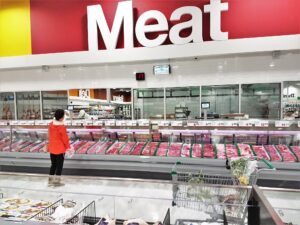
Fresh Meat Displays
LED Lighting Solutions for Display Cases
Conventional supermarket meat display lighting not only causes premature browning of meat but also accelerates bacterial growth and distorts the natural color of fresh cuts. For purveyors of premium meat, such as independent grocers and butcher shops, maintaining meat’s quality is paramount. This is where specialized lighting solutions like Promolux come into play.
Promolux lamps and LED lighting are designed to complement the presentation of fresh foods, safeguarding their color, juiciness, and texture. Furthermore, they help extend the shelf life of perishable food items.
Color and Meat Freshness in Grocery Store Display Cases
40% of Consumers Judge Based on Color
The visual appeal of meat plays a significant role in consumer purchasing decisions. Research indicates that the leanest and most brightly colored meat cuts are perceived as the freshest. In fact, over 40% of consumers judge meat freshness based on its color.
Customer preferences vary by region. For instance, in Colorado, the color of muscle and fat is a key quality indicator, while in Missouri, lean tissue color signifies freshness. It’s clear that when meat appears less fresh due to inadequate lighting, it often remains unsold.
Color of Cured Meats in Grocery Store Merchandisers
Maintain Cured Meat’s Color
Curing solutions, containing nitric oxide (NO), react with myoglobin in meat to produce the vibrant red pigment nitric oxide myoglobin (MbNO). However, this pigment is susceptible to deterioration, especially when exposed to light and oxygen. The result is the conversion of MbNO to metmyoglobin nitrite, leading to grey meat. Heat exacerbates this process, transforming it into the green pigment nitrihemin.
To maintain cured meat color, proper storage and protective measures are essential. These include vacuum packaging and storing the meat in darkness to prevent exposure to harmful visible spectrum and ultraviolet light, elevated temperatures, and oxygen.
Cured Meats and UV Light Sensitivity
Cured Meat Display LEDs
UV light has a particularly adverse impact on cured meats, especially hams. Prolonged exposure to UV and visible light, combined with oxygen and curing salts, causes the breakdown of cured meats, turning them green.
The color of cooked cured meat is more stable, but it remains sensitive to discoloration from light, temperature, and oxygen. As a result, cooked cured meats are often sold in vacuum packaging.
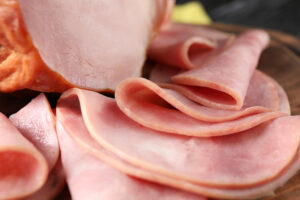
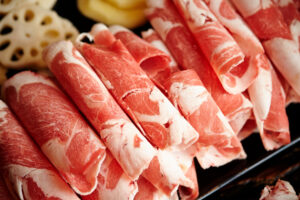
Color of Frozen Bacon and Its Sensitivity to Oxidative Reactions
Frozen bacon has a notably shorter shelf life compared to other frozen meats due to its sensitivity to oxidative reactions. High levels of sodium chloride, especially in leaner bacon, expedite the conversion of nitric oxide myoglobin to metmyoglobin nitrite, resulting in the grey pigment.
Color of Fresh Beef in Retail Meat Display Cases
Red, red …beef
Consumer perception of beef freshness is heavily influenced by its color. Consumers tend to prefer bright red beef cuts, regardless of the actual taste and tenderness.
Beef that isn’t sold when it’s optimally red, particularly during the blooming phase, poses a challenge for retailers. Consumers are often hesitant to purchase meat that doesn’t meet their color expectations. This can lead to retailers selling it at reduced prices, repackaging it, or even discarding it, despite the meat being safe to eat.
Color of Fresh Meat in Supermarket Display Cases
The color of fresh meat is pivotal in forming consumers’ initial impressions and affects their choices. The pigmented protein myoglobin, which determines meat color, undergoes various chemical reactions triggered by light, heat, and oxygen.
Temperature and Fresh Meat Color in Supermarket Meat Cabinets
Temperatures play a significant role in meat quality. Meat displayed under Promolux lamps with a Promolux filter maintains its optimal red color, freshness, low bacterial count, and minimal metmyoglobin levels. In contrast, meat displayed under standard supermarket lighting becomes brown and decomposes rapidly.
Even slight temperature increases have a profound impact on bacterial growth and meat spoilage. Ordinary display case lighting emits heat and radiation, raising the surface temperature of displayed meat beyond the refrigerator’s level.
pH and Fresh Meat Color in Grocery Store Meat Cabinets
The pH of fresh meat naturally drops from about 7 to approximately 5.5 over 24 hours after slaughter. However, various factors, including genetics and carcass handling, can affect muscle tissue pH negatively.
Rapid pH drops result in pale, soft, and exudative meat (PSE), while a lack of pH drop or a high pH level leads to dark, firm, and dry meat (DFD). DFD meat has difficulty absorbing oxygen and blooming, a problem frequently encountered with pork.
This organized structure clarifies the significance of specialized lighting, such as Promolux, in preserving the quality and visual appeal of fresh meat products in supermarket displays.
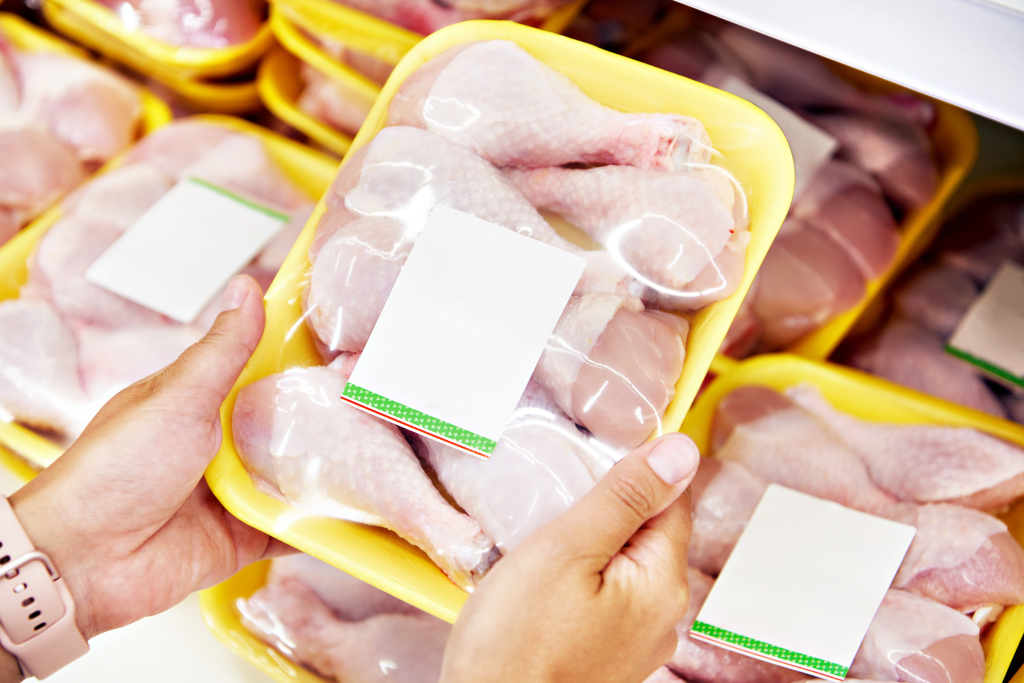
Color of Fresh Poultry in Refrigerated Supermarket Display Cases
The color of fresh poultry in refrigerated supermarket display cases can vary widely. Raw chicken and turkey can come in a range of colors including bluish white, yellow, pale tan, and pink, depending upon the part of the bird and the bird’s diet, age, breed, amount of fat, and exercise habits.
However, different light sources affect the perceived color of the poultry because they have different spectral components, so the same chicken part can appears to be several different colors. For example, a panel described a chicken leg as pink or red when it was under an incandescent light, brown when under a fluorescent light, and brown to purple under a metal-halide light.
Since many studies have found that color is one of the fundamental factors consumers consider when purchasing chicken and turkey, it is vital that the poultry be displayed in lighting that does not hide its fresh appearance.
Color of Fresh Pork in Meat Department Merchandisers
Pork color was found to be a major consideration for consumers in their decision to buy pork cuts.The color of fresh pork in meat department merchandisers was found to be a major consideration for consumers in their decision to buy pork cuts. Fresh pork is optimally pink. In one study, darker colored pork was preferred over pale pork, and consumers tended to avoid brown or grey pork which was interpreted as spoiled or old, even though this discoloration occurs long before the meat is spoiled in most cases.
Paler cuts of pork are thought to be tough and dry when cooked. Neither extreme of pale or dark is ideal and both are considered problems in the pork industry caused by genetics and the handling of the pig before and after slaughter.
Both PSE pork (pale, soft, and exudative or oozing) and DFD pork (dark, firm, and dry) can be affected by the amount of water in and on the pork cut. This water escapes from meat with a low pH (< 5.4) and can scatter light, making the pork appear to be lighter than it really is. In addition, oxygen permeable polyvinyl wrapping causes DFD pork to appear darker than if it is in vacuum packaging, and less appealing than medium pink pork cuts. Consumers tended to avoid pale and wet pork, preferring cuts that were medium or dark pink and then within that category preferring the dryer cuts.
Effect of Supermarket Display Case Lighting on Modified Atmosphere Packaging (MAP) Meat
The rates of oxidation and decomposition can be slowed by the use of barrier films and various gas combinations in modified atmosphere packaging (MAP), but radiation from retail lighting, especially UV radiation but also visible spectrum radiation, can still initiate oxidation and spoilage as all wavelengths of light penetrate clear packaging to some extent.
Wrapping fresh meat provides the opportunity to encase the meat in an atmosphere composed of a specific combination of gases, which allows retailers to control the timing of meat blooming and prolongs the storage life of the meat.
Modified atmospheres range from Controlled Atmosphere Packaging (CAP), which is 100% carbon dioxide and maintains the initial purple color of freshly slaughtered meat, to high oxygen Modified Atmosphere Packaging (MAP), which contains 70% oxygen and 30% carbon dioxide and is ideal for initiating meat blooming, the change in meat color from purple to bright red.
MAP with high oxygen concentrations helps to keep the red pigment stable within the muscle tissue for twice as long as meat exposed to air. In one study beef in high oxygen (70% oxygen and 30% carbon dioxide) modified atmosphere packaging remained fresh for four weeks at -1.5°C, and three weeks at 0°C.
In addition, the transparent film can allow a greenhouse effect to occur especially when high intensity spotlights are used, in which the radiation from the lamp heats the meat beneath the wrapping and the heat is then trapped there, causing the moisture within the meat to evaporate and then condense on the inside of the package.
As meat case lighting penetrates the transparent meat wrapping surrounding the modified atmosphere, a greenhouse effect develops in which the meat absorbs ultraviolet and harmful yellow wavelength radiation as heat which cannot escape from the polyvinyl packaging and is then trapped next to the surface of the meat. This heat can cause moisture within the meat tissue to evaporate and then condense on the inside of the wrapping as it too is trapped. This provides an ideal environment for the growth of bacteria, which accelerates the discoloration and decomposition processes, and for the growth of food borne pathogens such as Listeria and Salmonella. A temperature increase of only a degree or two can cause fresh meat to spoil at much faster rates, reducing the shelf life of fresh meat displays.
However, even in modified atmosphere packaging, the lamps used in the meat display cases can have a tremendous impact on the shelf life of beef, poultry, pork, and lamb. Exposure to light causes myoglobin to oxidize to metmyoglobin, a chemical reaction that causes fresh meat to lose its bright red bloom and become brown. In a study conducted at the University of Zaragoza, beef steaks in modified atmospheres of 70% oxygen, 20% carbon dioxide, and 10% nitrogen were exposed to three types of light, with a control sample kept in darkness. Beef steaks displayed under regular fluorescent lamps quickly absorbed the ultraviolet light emitted by the lamps, causing the steaks to turn brown and decompose as bacteria multiplied exponentially on the surface of the steaks. In contrast, steaks displayed under low UV Promolux lamps, and those under regular lamps blocked by Promolux filters, maintained virtually the same freshness and bright red color over the 28 days of the study as the beef stored in the dark. Exposure to ultraviolet light is therefore a much stronger factor than MAP in maintaining meat freshness and meat bloom.
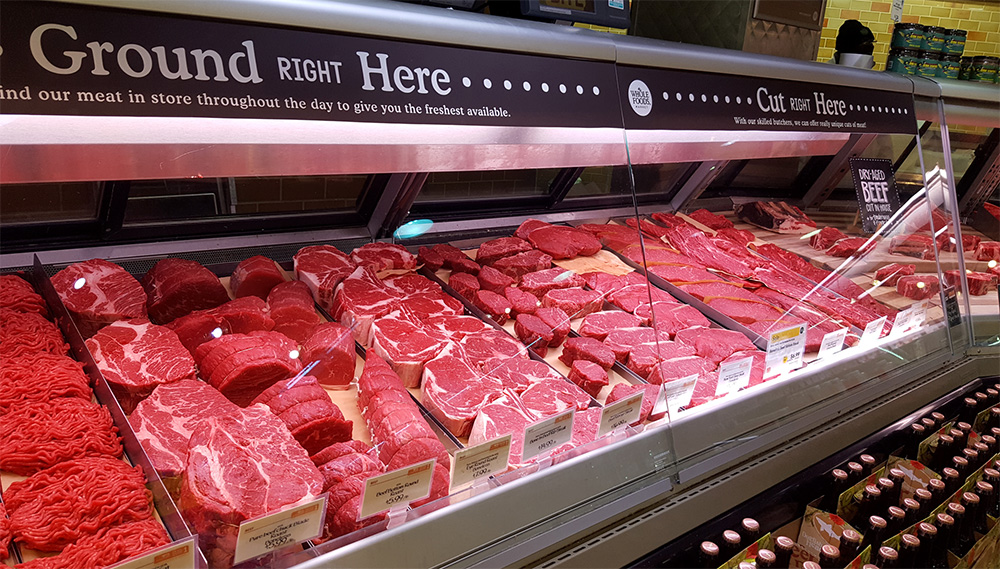
Fresh Beef Bacteria in Grocery Store Meat Cabinets
Gourmet LED Lighting Solutions for Top-Notch Display Cases
The microorganisms that attach rapidly to fresh beef and are primarily responsible for beef spoilage in grocery store meat cabinets are psychrotrophic bacteria, meaning those that are able to grow in cold temperatures, and tend to be in the genus Pseudomonas. While these bacteria are not harmful per se, they contribute to the discoloration and spoilage of beef by accelerating the oxidation of myoglobin to myoglobin, the pigment that causes fresh meat to look brown, reducing the shelf life of fresh beef to 2 to 3 days. Eighty percent of Canadian beef is sold domestically and internationally in vacuum packages, which are vulnerable to spoilage by lactic acid bacteria.
In most cases, the bacteria are only present on the surface of the meat, in the outer few millimetres. The exceptions are ground beef, where the grinding process spreads the bacteria throughout the meat, and highly spoiled beef.
Fresh Beef Displays in Supermarket Meat Department Showcases
LED Lighting Solutions to Reduce Food Waste
The National Cattlemen’s Beef Association and other groups estimate that up to $1 billion in beef are wasted each year in the United States, a loss of four to five percent of the wholesale price, while in Canada it is estimated that $200 million are lost each year as a result of beef spoilage in supermarket meat departments. Beef display lighting that emits high levels of UV radiation accelerates the discoloration and spoilage of beef.
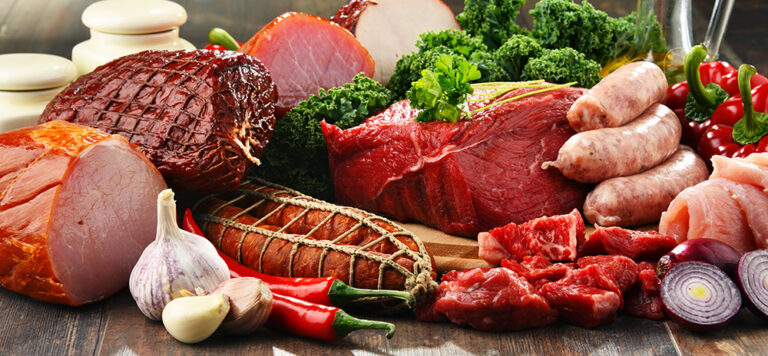
Fresh Meat Blooming in Grocery Store and Butcher Merchandisers
Myoglobin is a protein pigment that stores and carries oxygen for muscle tissue metabolism. It contains an iron atom that can bind with oxygen, water, or nitric oxide (responsible for the color of cured meats) and can oxidize (lose an electron), chemical reactions that cause the color of fresh meat to change.
In several studies it has been found that color is very important to consumers when they select meat; for beef the ideal color is bright cherry red; for lamb, dark cherry red; for pork, grayish pink; and for veal, pale pink. These colors are achieved by allowing the fresh meat to bloom.
In a freshly slaughtered animal, myoglobin is purple, which gives the meat a dark purplish hue. The meat is often preserved at this color by packaging it in airtight, dark containers while the meat is stored or transported. Within half an hour of exposure to oxygen and light, the meat blooms: myoglobin becomes oxygenated as oxygen is absorbed by the meat and binds to the iron atom, forming oxymyoglobin, a characteristically red pigment that causes the meat to turn from purple to the appropriate shade of red or pink.
The exact shade of red is determined by the amount of myoglobin in the muscle tissue, which can vary depending upon the animal’s diet, age, sex, and species, and the amount of exercise it had. Meat from older animals and meat from muscles that were strengthened through exercise tend to be darker. Thus beef, which has a higher concentration of myoglobin than pork, lamb, or chicken, is bright cherry red, while veal from a milk-fed penned calf and pork are pale pink.
While this oxygenation is reversible, and the meat pigments fluctuate between these two purple and red colors regularly, other reactions soon become more predominant. The blooming period is therefore short-lived, but can be prolonged by minimizing the exposure to ultraviolet and visible spectrum radiation, maintaining low temperatures, and using modified atmosphere packaging (MAP) containing very high concentrations of oxygen.
Fresh Meat Discoloration in Retail Meat Showcases
With continued exposure to light, oxymyoglobin and myoglobin oxidize (the iron atom loses an electron) to form metmyoglobin, a brown or gray pigment. Metmyoglobin is also produced when oxygen is no longer available at high concentrations because it has been absorbed by the meat during the blooming process and/or because it has been consumed by aerobic bacteria as they grow.
This oxidation and discoloration occurs in equilibrium with the oxygenation reaction that causes fresh meat to bloom and for a time is reversible, with all three pigments found in fresh meat at any given time. But as the meat ages and the reducing enzymes become exhausted, the formation of the brown metmyoglobin pigment can no longer be reversed, and the fresh meat’s appealing red or pink bloom is replaced by an unappetizing and permanent brown or grey color.
Meat pigment oxidation is initiated when the light source emits high levels of certain wavelengths of the spectrum that match Soret bands, wavelengths that are characteristically absorbed by myoglobin. Ultraviolet and yellow light are strongly absorbed by myoglobin, so any light source that emits high levels of these wavelengths will tend to accelerate the rate of meat decomposition.
Various studies have confirmed that ultraviolet light leads to the discoloration of meat by accelerating the production of metmyoglobin. Light is so crucial to this decomposition process that when packaged meat from the same animal are stacked in a refrigerated meat display case, the packages that are kept in relative darkness at the bottom of the pile will remain red or pink, while the packages at the top that are exposed to the meat display lighting will soon turn brown.
The intensity of the damaging wavelengths of light, especially 254 nm UV wavelengths and 560 to 630 nm yellow wavelengths, and the extent to which the meat package is light permeable determine the rate of meat discoloration caused by photooxidation.
Other factors that influence the rate of metmyoglobin production are the temperature of the meat, the amount of oxygen available, and the amount of bacteria present. However, even frozen beef displayed at -25° C will discolor as the myoglobin continues to oxidize under display case lighting.
Fresh Poultry Displays In Grocery Store Meat Merchandisers
Health conscious consumers have been purchasing increasing amounts of poultry in recent years, raising awareness of food safety and harmful bacteria such as Salmonella, and demanding high quality meat. Poultry display lighting that emits UV raises surface temperatures of meat packages, providing an ideal environment for bacterial growth.
Promolux Safe Spectrum balanced full spectrum lamps and LEDs emit lower levels of heat and ultraviolet radiation than regular supermarket lamps, thus reducing the rate of poultry decomposition.
However, different light sources affect the perceived color of the poultry because they have different spectral components, so the same chicken part can appears to be several different colors. For example, a panel described a chicken leg as pink or red when it was under an incandescent light, brown when under a fluorescent light, and brown to purple under a metal-halide light.
Since many studies have found that color is one of the fundamental factors consumers consider when purchasing chicken and turkey, it is vital that the poultry be displayed in lighting that does not hide its fresh appearance.
Fresh Pork Displays in Supermarket Meat Display Cases
Pork color is the most critical deciding factor for consumers when they select pork cuts from supermarket meat display cases. Studies have found that pork shelf life is limited more by the development of a brown or grey color, which develops long before the meat has spoiled, than by any other factor. For pork, this discoloration is accelerated by increased surface temperatures which can result from using meat display lighting that emits large quantities of UV and harmful visible spectrum radiation. These increased temperatures can also cause pork fat to become rancid.
Promolux True Color Definition Lamps and LEDs
Promolux Safe Spectrum balanced full spectrum fluorescent lamps and LEDs emit lower levels of heat and ultraviolet radiation than regular supermarket fluorescent lamps, thus reducing the rate of pork decomposition. Compared to other fluorescent lighting, Promolux lamps emit 86% lower UV B radiation, a shorter wavelength that penetrates and causes heating, and 52% lower UV A radiation, a longer wavelength that tends to affect surfaces.
Because Promolux lamps and LEDs are designed for true color definition, they have a more balanced visible spectrum than other fluorescent lamps. The yellow and green wavelengths that are predominant in regular fluorescent lighting are the most damaging wavelengths in the visible spectrum. Promolux lamps emit a more balanced range of wavelengths, including more of the red and blue wavelengths and more moderate levels of the yellow and green wavelengths.
It is impossible to create a natural light that does not have any yellow or green wavelengths, so light sources will always be damaging to some extent. However, in a study conducted by the University of Zaragoza, meat that was displayed under Promolux low UV balanced spectrum lamps stayed nearly as fresh as meat kept in the dark, while meat that was displayed under regular fluorescent lighting quickly turned brown and began to decompose.
Lighting Source and Perceived Meat Color in Butcher, Grocery, and Local Meat Shops
Meat color is a reflection of the wavelengths of light that are not absorbed by the meat, and is therefore a relative phenomenon determined by the spectrum emitted by the light source.
Supermarket fluorescent and LED lighting emits high levels of green and yellow wavelengths and very little of the red and blue wavelengths, which causes red lean tissue to appear brown, and white fat to look yellow or greenish.
Consumers judge the freshness of meat by its color, but many lighting sources distort true colors.
Incandescent lights are very strong in the yellow wavelengths and weaker in blue and green wavelengths, and we tend to think, erroneously, that these lamps reveal true colors.
For example, under experimental conditions, a beef steak that looked very red under incandescent lighting appeared less red under fluorescent or metal-halide lighting, while a chicken leg that appeared to be pink or red under incandescent lighting looked brown under a fluorescent lamp and purple or brown under a metal-halide lamp. Some soft white fluorescent lamps can make muscle tissue look red, but bones and fat appear pink. However, the predominance of yellow wavelengths in the spectrums of incandescent and deluxe warm white fluorescent lamps can give fat and bones a yellowish tinge, which can be very distasteful to consumers.
If meat displays do not look appealing even when the meat is blooming, consumers will not be tempted to buy, and the meat will spoil before it can be sold.
Lipid Oxidation of Meat in Refrigerated Supermarket Display Cases
Meat with a high fat content, such as ground meat, sausages, and bacon, are susceptible to lipid oxidation. Meat with a high fat content, such as ground meat, sausages, and bacon, are susceptible to lipid oxidation, a photochemical reaction between light and fat lipids which leads to rancidity, noticeable by a bad smell and a yellowish tinge.
Bacon and sausage, because of their high fat content, have a much shorter shelf life than other meats; even when frozen, their shelf life is only three months long. Ground meat and sausages are more susceptible to spoilage because the fats are evenly dispersed throughout the meat.
The chlorophyll in herbs and spices commonly added to sausages and processed meat absorbs light, accelerating the rate of lipid oxidation. Similarly, vegetable based food dyes added to cured or processed meat will also absorb light and increase the rate of oxidation. The rate of spoilage can vary depending upon the salts and chemicals used, which can speed up the decomposition of the meat or its oxidation.
Meat Re-wraps in Grocery Store Meat Cabinets
Each year, the US retail beef industry loses up to one billion dollars in lost sales, four to five percent of the wholesale price, due to meat that does not sell because it is no longer blooming, even though this meat is still safe to eat.
The Canadian beef industry loses $200 million per year from vacuum packed meat that spoiled because it did not sell in a timely way.
Meat that doesn’t sell can be sold more cheaply by re-wrapping it, such as grinding it, marinating it, or even cooking it, but this still represents a loss in terms of additional labor costs and realizing a smaller profit. Grinding re-wrapped meat exposes the meat to air and light and can accelerate bacterial growth.
The best solution is to display the meat to best advantage when it is blooming, which will naturally lead to increased sales allowing the grocery store to realize its full profit.
Processed and Cured Meats in Retail Meat Showcases
Ground meats have a shorter shelf life due to their exposure to light, air, and bacteria. Processed meats in retail meat showcases have a shorter shelf life than other meats due to their exposure to light, air, and bacteria. Any herbs and spices that are added in the grinding process absorb light from display case lighting, accelerating meat spoilage. Cured meats are very sensitive to the discoloring effects of ultraviolet radiation from regular meat display lights.
Promolux lamps and LEDs emit lower levels of UV radiation, resulting in a longer shelf life for processed and cured meats.
Retail Shelf Life of Processed Meat Displays
The process of grinding meat and stirring in spices and other ingredients introduces air and oxygen throughout the product. The process of grinding meat and stirring in spices and other ingredients introduces air and oxygen throughout the product, making the preferred red bloom color of ground beef less stable by exhausting the reducing enzymes that allow the meat pigment to change from purple (myoglobin) to red (oxymyoglobin) and back again, and prevent these two from turning brown (metmyoglobin).
The center of a package of ground beef, for example, is often grayish brown because there is not enough oxygen to stabilize the pigment as red oxymyoglobin, but there was enough oxygen and exposure to light when the product was being ground and mixed to allow the brown pigment metmyoglobin to form.
A fresh roast, in contrast, would be purplish in the center. The shelf life of processed meat is reduced proportionately to the amount of exposure to air: the longer the product is mixed, and the smaller the meat is ground, the shorter the product’s shelf life.
Herbs and spices contain chlorophyll which naturally absorbs light, so when these ingredients are added to processed raw meats or used in marinades, the discoloration process is accelerated. The absorbed light is retained as heat which encourages bacterial growth and spoilage, and as the oxygen concentrations become lower, brown coloring becomes predominant.
Spoilage of Fresh Meat in Commercial Showcases
The growth of bacteria contributes to the discoloration of meat and leads to spoilage. Most display case lighting emits radiation which raises meat surface temperatures even in refrigerated display cases, leading to exponential bacterial growth.
Grocery stores that switch to Promolux lamps and LEDs soon notice that their meat display cases no longer smell unclean, because the lighting does not heat the blood and residue from meat packages to temperatures that encourage bacteria to grow.
Fresh Meat Displays
Regular supermarket meat display case lighting shortens the brief period when meat is blooming, turning it brown prematurely; increases the rate of bacterial growth; and distorts the meat’s natural color.
Retrofitting meat showcases with high color definition and long life LEDs delivers incomparable value and savings to a retail operation. Independent grocers and butcher shops work hard to offer their customers premium cuts of meat, that is why it is so important to use a specialty display case light like Promolux. Promolux lamps and LED lighting compliment the merchandising of fresh foods and supports the retention of color, juices and texture all the while helping to extend the shelf life of the perishable food item.
Studies of Pork Shelf Life in Refrigerated Grocery Store Meat Cabinets
Early studies of pork suggested that surface temperature is a more important factor than exposure to light for the discoloration of pork and the growth of microorganisms on pork displays in refrigerated grocery store meat cabinets. However, the surface temperature of pork has been found to increase proportionately with the intensity of the lighting, regardless of whether the lamp is an incandescent or a cool white fluorescent lamp.
With all meat, even slight increases in surface temperatures accelerate oxidation and allow bacteria to grow exponentially, causing the meat to turn brown and to decompose. Later studies have shown that even with the lower levels of myoglobin in pork as compared to beef, pork is still sensitive to the oxidizing effects of light and will become discolored, turning brown or grey, after prolonged exposure to light and UV radiation, impacting sales even though this color change is not as dramatic as it is in cuts of beef.
The ideal storage temperature for pork is -1°C (30°F) for unwrapped meat or -1.5°C for wrapped meat, as the water within the muscle does not freeze substantially until -2°C, but spoilage bacteria grows slowly at -3°C with increasing rates as the temperature rises. With every temperature degree higher than the optimal storage temperature, shelf life is reduced by at least 10%. Therefore tiny temperature changes can drastically affect fresh pork shelf life; meat kept at -1.5°C will last twice as long as meat stored at 2°C.
In one study, more than thirty percent of pork cuts stored at 2°C and 5°C were judged to be unacceptable after being displayed for 24 to 30 hours, as compared to only 15% of pork stored at -1.5°C. Studies have found that surface temperatures of pork loin roasts are often at 10°C, and can vary from 4 to 25°C higher than the temperature of the refrigerated display case. Discoloration occurred more quickly for pork chops displayed under cool incandescent flood lights than pork displayed under other types of lights, in part because the intensity of the lighting increased the surface temperature by 3 to 14°F.
High temperatures affect pork in two ways. First, they contribute to the growth of microorganisms and discoloration. Second, pork fats are vulnerable to lipid oxidation leading to rancidity, which can occur when the pork is subjected to abusively high temperatures.
Studies of Poultry Shelf Life in Refrigerated Retail Meat Cabinets
Even with the lower levels of myoglobin in poultry, poultry meat is still sensitive to the oxidizing effects of light.Studies of poultry shelf life in refrigerated retail meat cabinets have shown that even with the lower levels of myoglobin in poultry, poultry meat is still sensitive to the oxidizing effects of light and will become discolored after prolonged exposure to light and UV radiation.
The rate of oxidation and decomposition has been slowed by the use of barrier films and various gas combinations in modified atmosphere packaging (MAP), but radiation from retail lighting, especially UV radiation but also radiation from the visible spectrum, can cause discoloration and spoilage as all wavelengths of light penetrate clear packaging to some extent.
In addition, the transparent film can allow a greenhouse effect to occur especially when high intensity spotlights are used, in which the radiation from the lamp heats the poultry beneath the wrapping and the heat is then trapped there, causing the moisture within the poultry to evaporate and then condense on the inside of the package.
Temperature and Spoilage in Grocery Store Meat Display Cases
The Canadian Meat Packers Council recommends that internal meat temperatures should not exceed 39°F or 4°C, and other studies have suggested that the optimal storage temperature for meat is just below the freezing point.
Psychrotrophic bacteria are capable of multiplying in refrigerated atmospheres between 26°F to 41°F (-3°C to 5°C) and grow at optimal rates at 68°F to 86°F (20°C to 30°C), but their growth can be restrained by keeping meat at 29°F or -1°C, which is also cold enough to prevent the growth of food-borne pathogens. The density of the meat prevents it from freezing at these temperatures, and though bacteria can grow at -3°C or colder, they grow much more slowly at cold temperatures.
Even small increases of a degree or two can result in an enormous increase in bacterial growth. For example, raising the temperature from -1.5°C to 2°C can cut the shelf life of meat in half. Bacteria on meat that is kept at 41°F or 5°C grows at twice the rate of bacteria on meat kept at 33.8°F or 1°C, and at 50°F or 10°C the rate of bacterial growth is triple.
Temperature has an even more profound effect on the spoilage rate of meat. Beef at 5°C spoiled three times faster, and beef at 10°C spoiled five times faster, than beef stored at 0°C. High meat surface temperatures not only encourage psychrotrophic bacteria to grow exponentially, accelerating the rate of discoloration and spoilage, but also provide ideal conditions for the growth of food borne pathogens such as Salmonella.
However, keeping meat displays at these ideal temperatures is challenging for retail meat stores. The actual surface temperature of displayed fresh meat is often much higher (4 to 25°C higher) than the temperature recorded at the display case thermometer, partly due to UV radiation from display case lighting, which penetrates meat packaging and heats the surface of the meat just as the sun can cause a sunburn on a cold winter day.
Various studies have found that surface temperatures of displayed meat are often as high as 10°C, with fluctuations from 25°F to 61°F (-5°C to 16°C) and internal temperatures sometimes above 50°F or 10°C. These fluctuations can be caused by the intensity of the display case lighting as well as defrosting cycles in the refrigeration display case, the temperature of the room, the design of the display case, and the location of the meat within the display case (meat near the top is warmer than meat at the bottom of the display).
Shelf life can be lengthened by controlling the temperature of the meat and by improving sanitation as the meat is being processed. While moving the meat to coolers overnight where they can be stored at 1°C will extend the shelf life of the meat to 5 days, this may not be worth the added labor costs and loss of refrigeration cooler space.
Temperature Fluctuations in Fresh Beef Merchandisers
Temperature has a profound effect on bacterial growth, even for psychrotrophic bacteria that can grow at cold temperatures. Bacteria typically found on fresh beef at 5°C (41°F) will grow at twice the rate of bacteria at 1°C (33.8°F), while at 10°C (50°F) bacteria will grow at triple this rate, quickly reducing the shelf life of the beef. In one study, beef stored at 5°C (41°F) spoiled at three times the rate of beef stored at 0°C (32°F), while beef stored at 10°C (50°F) spoiled at five times that rate.
The Canadian Meat Packers Council recommends that internal meat temperatures should not exceed 39°F or 4°C, and several researchers have recommended that meat surface temperatures should be near the freezing point.
However, various studies have found that surface temperatures of displayed meat can vary from 25°F to 68°F (-5 °C to 20°C), with internal temperatures sometimes above 50°F or 10°C, and average steak surface temperatures 8 to 10°C higher than the ideal storage temperature recorded on the display case thermometer, sometimes fluctuating to 20° C higher particularly when the meat was exposed to meat display case lighting.
Displayed ground beef temperatures have been measured at 8°C to 13°C (46°F to 56°F) in one study and ranged from more than 4°C to 25°C (39°F to 77°F) in other surveys.
Shelf life of beef stored in closed refrigerators at 1°C was 5 to 9 days in one study, and another found that rib steaks at 1°C maintained ideal colors for 9 days, but ideal colors lasted only 2.5 days when kept at 10°C.
Lighting sources are one of the major factors in increasing the surface temperature of beef steaks. Light radiation penetrates clear packaging and is absorbed by the meat as heat, forming a greenhouse effect in which the heat becomes trapped beneath the wrapping, often raising meat surface temperatures far beyond recommended storage temperatures and thereby creating an environment ideal for exponential bacterial growth.
Controlling the surface temperature of beef through low-UV lighting sources is important to prevent exponential bacteria growth, discoloration, and spoilage. Processing beef with sanitized cutting methods and maintaining low display temperatures (1°C) have been found to result in longer shelf life and less discoloration.
Other studies have revealed that even frozen beef displayed at -25°C will discolor as the myoglobin continues to oxidize under display case lighting. Temperature tends to be the most significant instigator of myoglobin oxidation in fresh meat, while for frozen meat the oxidation is light-induced.
Ultraviolet Light in Fresh Beef Display Cases
Early studies found that beef stored in the dark over a period of three to ten days did not change color significantly, while beef stored under fluorescent lighting for the same amount of time began to turn brown after only 5 days.
In a 28 day study conducted at the University of Zaragoza in 2000, ultraviolet light was shown to have a profound effect on the rate of beef spoilage and the creation of metmyoglobin, the pigment that gives meat a brownish surface color. All fresh beef in this study were packaged in a modified atmosphere of 70% oxygen, 20% carbon dioxide, and 10% nitrogen.
Beef displayed under Promolux lamps and regular fluorescent lights with a Promolux filter, which both block UV radiation, maintained virtually the same bright red color, fresh smell, low bacterial count, and low levels of metmyoglobin as beef stored in the dark, while beef displayed under a standard supermarket fluorescent light became brown and decomposed rapidly after only 12 days.
After 17 days, meat under regular supermarket lighting had much larger percentages of surface metmyoglobin, higher levels of psychrotrophic bacteria, and poorer odor quality than the beef displayed under Promolux lights or Promolux filters, or beef kept in darkness.
This study proved that ultraviolet light as emitted by standard retail fluorescent lamps accelerates bacteria growth, the brown discoloration of beef caused by high concentrations of metmyoglobin, and lipid oxidation which leads to rancidity.
Visual Appeal of Fresh Meat in Supermarket Merchandisers
Consumers judge the freshness of meat by its color, but many lighting sources distort true colors.
Promolux lamps and LED lighting protect perishable foods like meat and provide retail display cases with the best possible light and color rendering to maximize your merchandising efforts. Promolux lamps are sold world-wide and are known as a leader in food retail merchandising for their showcase appeal and product protection.
What sets Promolux lamps and LED lighting apart is its merchandising effect on fresh product. Food counters and display cases that use Promolux house products whose colors are all very deep and visually appealing. Promolux allows each individual color to be shown truly and equally – including whites which are very crisp and clean.
How can we help you?
To learn more about Promolux lighting, including our volume pricing options, or to find a distributor in your area, please call, email, or follow the link to fill in the contact form. A member of our team will be in touch with you as soon as possible.
Toll Free (North America): 1-800-519-1222
Phone: 1-250-743-1222
Email: info@promolux.com


